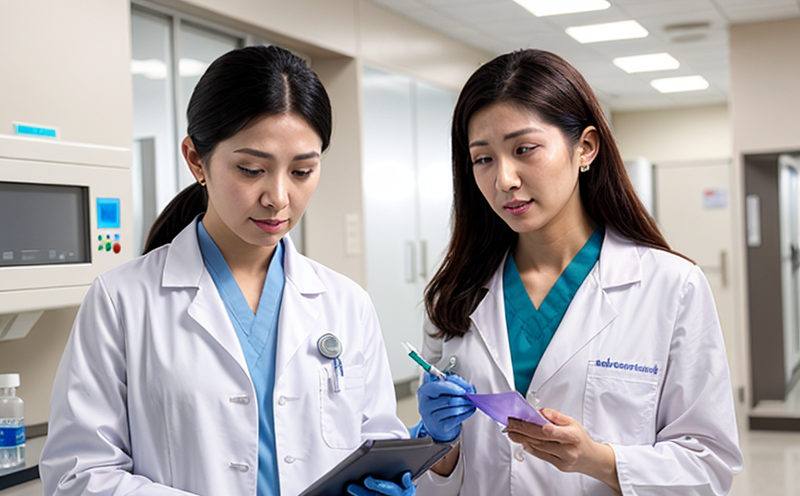EP Impurity Testing of Biopharmaceuticals
The European Pharmacopoeia (EP) impurity testing is a critical quality assurance process aimed at ensuring the purity and safety of biopharmaceutical products. This service ensures that all active pharmaceutical ingredients (APIs), excipients, and other components meet stringent regulatory standards set forth by the EP.
Biopharmaceuticals are complex molecules such as proteins, peptides, monoclonal antibodies, and nucleic acids. These compounds can be highly susceptible to impurities due to their structural complexity and the manufacturing processes involved. Impurities in these products could lead to adverse effects on patient safety or efficacy. Therefore, EP impurity testing is essential for both quality control and compliance with international regulatory standards.
The service involves a series of tests designed to identify, quantify, and qualify any potential impurities present in biopharmaceuticals. The methodology typically includes:
- Sample preparation
- High-performance liquid chromatography (HPLC) for separation and quantification
- Detection using UV/Vis spectroscopy or mass spectrometry
- Data analysis to determine compliance with EP limits
The primary goal of this testing is to ensure that the final product is safe, effective, and consistent. This service supports pharmaceutical companies in meeting their quality goals and regulatory requirements.
Biopharmaceuticals are often produced through recombinant DNA technology or cell culture processes, which can introduce various impurities such as host cell proteins (HCP), nucleic acids, lipids, and residual solvents. These contaminants must be rigorously controlled to meet the stringent quality standards set by regulatory bodies.
Understanding the specific requirements of biopharmaceuticals is crucial in this testing process. The complexity of these molecules requires advanced analytical techniques that can provide detailed information about impurities. This service ensures that all tests are conducted using state-of-the-art equipment and follow current best practices, thereby maintaining high standards of quality assurance.
The EP impurity testing also helps manufacturers to identify potential issues early in the development process, allowing for corrective actions before they become significant problems. By adhering strictly to the EP guidelines, pharmaceutical companies can ensure that their products meet rigorous safety and efficacy standards.
Regulatory compliance is a key aspect of this service, as biopharmaceuticals must comply with not only European Pharmacopoeia standards but also other international regulations such as FDA and EMA. This ensures that the testing aligns with global standards for safety and quality.
Scope and Methodology
The scope of EP impurity testing encompasses a wide range of analyses designed to ensure the purity of biopharmaceutical products. This includes:
- Detection and quantification of host cell proteins (HCP)
- Analyses for residual solvents
- Screening for nucleic acids
- Identifying and quantifying other adventitious agents such as viruses, mycoplasmas, and endotoxins
The methodology involves a series of steps to ensure accurate and reliable results:
- Sample preparation: This step ensures that the sample is properly prepared for analysis. It may include dilution, filtration, or other necessary treatments.
- Liquid Chromatography-Mass Spectrometry (LC-MS): This advanced technique allows for precise identification and quantification of impurities at trace levels.
- High-Performance Liquid Chromatography (HPLC): Used to separate components of the sample, HPLC is crucial for identifying impurities in complex mixtures.
- Data analysis: Analyzing the data obtained from LC-MS and HPLC helps determine whether the product meets EP specifications.
The use of cutting-edge technology ensures that even very low levels of impurities can be detected, providing a comprehensive understanding of the purity of the biopharmaceuticals being tested.
Accurate results are essential for regulatory compliance and ensuring patient safety. By adhering to strict protocols and using advanced technologies, this service guarantees reliable outcomes.
Why Choose This Test
- Enhances product safety and compliance with regulatory standards
- Aids in early identification and mitigation of potential risks
- Simplifies the regulatory submission process for pharmaceutical companies
This comprehensive testing service provides peace of mind to both manufacturers and regulators, ensuring that biopharmaceuticals are safe and effective.
Competitive Advantage and Market Impact
- Regulatory compliance: By adhering to the strict standards set by the European Pharmacopoeia, pharmaceutical companies can ensure that their products meet global regulatory requirements.
- Patient safety: Identifying and quantifying impurities helps minimize risks associated with biopharmaceuticals, thereby improving patient outcomes.
- Quality assurance: This service provides a high level of confidence in the quality of the final product, which is essential for maintaining customer trust and satisfaction.
- Market differentiation: Offering EP impurity testing demonstrates a commitment to quality and compliance, setting companies apart from competitors who may not offer such rigorous testing.
- Cost savings: Early detection of potential issues through this service can prevent costly recalls and product withdrawals later in the development process.
The implementation of EP impurity testing is a strategic advantage that supports long-term success in the pharmaceutical industry. It not only enhances product quality but also strengthens market positioning, ensuring sustained compliance with regulatory requirements.





